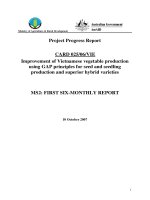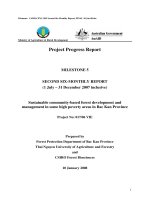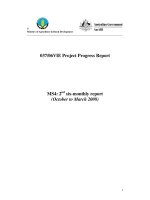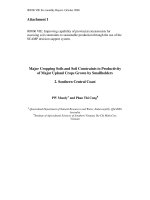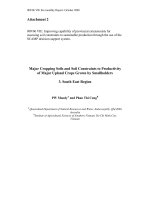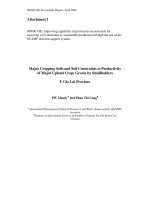Dự án nông nghiệp " Why use legume inoculant on Groundnut! " potx
Bạn đang xem bản rút gọn của tài liệu. Xem và tải ngay bản đầy đủ của tài liệu tại đây (515.89 KB, 8 trang )
Appendix 4
Why use legume
inoculant on
Groundnut!
Using legume inoculant is a better way of
adding nitrogen to your groundnut crop
because it is:
• cheaper than buying nitrogen
fertilizer and
• environmentally healthy
G
roundnuts belong to a
group of plants known as
legumes. Legumes have
the special ability to
produce their own
nitrogen through a special (symbiotic)
relationship they have with certain soil
microbes or root-nodule bacteria. The
bacteria, commonly called rhizobia
invade (infect) the roots of the plant
and form nodules (nodulation). Rhizobia
in the nodules nourished by the plant
‘fix’ or convert atmospheric nitrogen
(N
2
) into compounds which the plant
utilizes for growth and grain production.
Root nodules become visible after about
2-3 weeks.
In Vietnam you now have access to these
rhizobia in the form of peat inoculants.
You can purchase and apply these
inoculants to your seed (inoculation) at
sowing time, and benefit from this chea
p
source of nitrogen.
By using legume inoculants on seed yo
u
will:
• grow healthy green plants withou
t
having to add nitrogen fertilizer
• achieve profitable grain yield
• contribute to higher availabl
e
nitrogen for any subsequent cro
p
such as rice as legumes leav
e
fixed nitrogen behind in the soil
• save money by using biologica
l
nitrogen instead of chemica
l
nitrogen
• be contributing to healthier, goo
d
farming practices which are bein
g
encouraged and implemented i
n
Vietnam.
For further information about legume
inoculants contact:
Tran Yen Thao
at: Oil Plants Institute, District 1, HO
CHI MINH CITY
phone: 84 8 9143024
How to inoculate your groundnut seed
with legume inoculant
It is very important to use the correct
legume inoculant for your groundnut
seed.
There are different inoculants for
different legumes. Legume inoculants
made using peat contain a very high
number of rhizobia bacteria. The
rhizobia are living organisms and very
sensitive to high temperature and
sunlight. Great care should be taken
when handling and storing them to
prevent the rhizobia from dying. The
rhizobial strain in each inoculant has
been carefully chosen by researchers to
ensure good nodulation and effective
nitrogen fixation in your crop. Nitrogen
fixed from the atmosphere can be as
high as 100 kg/ha
Inoculation of seed
o Select the inoculant for groundnut
and calculate the weight of inoculant
you need for the amount of seed to
be sown. (about 1 kg / 100Kg of seed)
o Place the inoculant (1 kg) in a clean
bucket and slowly add up to 4 litre of
clean drinking water. Continue to stir
until a smooth slurry is formed
o Add a small amount of water to your
seeds to dampen the surface, and
then pour the wetted seeds into the
bucket containing your inoculant
slurry.
o Keeping the bucket out of direct
sunlight, carefully mix together until
the seeds are evenly coated with the
inoculant.
o The inoculated seed should be sown
immediately or within 5 hours after
inoculation into moist soil.
o Check roots for nodules after 4 weeks
o Nodules should be pink inside when cut
in half. This indicates that nitrogen
fixation is occurring
For further information about legume
inoculants contact:
Tran Yen Thao
at: Oil Plants Institute, District 1, HO
CHI MINH CITY
phone: 84 8 9143024
Appendix 5
Visit to Cu Chi Bio-Chemical Fertilizer Joint Stock Company 27/02/2008
This Company was the first of 2 visited by staff
from NSW DPI (Elizabeth Hartley and Greg
Gemell), Dr Roz Deaker of Sydney University
and Tran Yen Thao of Oil Plants Institute HCMC
(Vietnam Project leader). The location is just over
1hr from Ho Chi Minh City. We met with the
Vice Director of the company for about 1 hr and
discussed the purpose of our visit; technology
transfer and the potential for commercial
collaboration and production of legume
inoculants in Vietnam.
We discussed a proposal whereby project staff
would supply legume inoculants and extension
material to farmers through the Cu Chi
company’s distribution network, after calculating
how big the farming area is. General information
would be provided first then more details later.
The Company distributes mineral fertilizer (N, P
and K) mixed in ratios according to the crop’s
requirements at different stages of growth and its
own make of bio-fertilizer using Azotobacter,
Trichoderma and another microorganism. The
bio-fertilizer is mixed in with the NPK.
Chemicals are imported form places such as Israel
and China.
Soybean and groundnut are grown in many
regions in the Mekong Delta area, South East and
up through the Central Highlands. Some
groundnut farmers in the Cu chi area are
expanding into vegetables. The Cu chi company
could easily meet the requirement and supply
their peat to produce legume inoculants of more
than 100 tonne. Based on the response from
farmers and the profitability of the venture the company will decide whether or not to invest
into legume inoculants. At this stage they could only be involved in free distribution of
legume inoculants along with their chemical and bio-fertilizers. If farmers respond positively
to using the rhizobial inoculants the company would be more interested in investment. There
is a problem in getting feedback from farmers as all are not connected by phone and are not
easily contactable.
Without seeing the facilities, it was imagined
that project persons could prepare starter
broths of rhizobia for inoculation of the
fermenter to produce a test run for addition to
peat in packets. The peat is used to make bio-
fertilizer inoculants. It is high in S content and
requires neutralisation. The pH is
approximately 3.00 and toxic to microbial
inoculant organisms. The peat is ground to a
Appendix 5
3mm powder, stacked in large piles (tonnes)
and later a water slurry of ammonium
sulphate, lime and molasses is added. The
microbials (Azotobacter, Trichoderma and
1 other) are also added at this stage.
Incubation is 12 days during which time the
peat gets very warm (about 45º) as it
ferments. The final product has a pH of
around 6.5 – 7.0. The microbials are
cultured in a large open concrete vat of
humic acid (extracted from soaked peat).
The finished product is then bagged for
sale. Moisture content of the peat starts at
30-40% but drops to around 25%. Random
samples are sent to the government testing
lab for certification.
It was decided after seeing the fermentation
of the microbials and the production of the
bio-fertiliser inoculants that this company
would not be suitable to produce legume
inoculants through its processes. However,
the company can be utilised as a possible
source of distribution of legume inoculants
to farmers in the south of Vietnam.
Photos:
Previous page:
• Peat stockpile
This page top to bottom
• Peat is sieved and stockpiled
• Microbes are cultured in an open
concrete vat
• Culture plus other ingredients are
trickled on and through the peat
stockpile and allowed to ferment for 12
days
• The product is rolled into prills
• Bio-fertilizer and other nutrients are
bagged for sale
Appendix 5
Visit to Thien Sinh Corporation “KOMIX” Bio-fertilizer Company 28/2/2008
The visit had been pre arranged by Tran Yen Thao
(Research Leader in Vietnam) via a letter of
introduction. The meeting began with Yen Thao
explaining the objectives of the project, the purpose of
our visit and the future prospects of an inoculant
industry in Vietnam. The meeting was arranged in 2
parts:
1. Introducing a new product: Given that Vietnamese farmers traditionally use bio-
fertilizer and chemical fertilizers, what is the best way to introduce new rhizobial
inoculants for application to soybean and groundnut. What is the best way to
promote and gain feedback on the use of rhizobial seed inoculants? We discussed
fundamental questions; regarding the carrier, can the rhizobia be supplied in un-
sterile peat? Sterilization costs would be very high if it was deemed necessary to
pre-sterilize the peat carrier. We discussed that the merit of using a sterile carrier
was to allow the slow-growing rhizobia to populate the peat without competition
from other organisms. Maintaining good survival within the peat enables a high
rhizobial number to be applied on seed at sowing. If un-sterile peat has to be used
then the rate of application would need to be determined. Currently Vietnamese
farmers apply up to 3t/ha bio-fertilizer, so a low application rate of 250g to 1kg/ha
of legume inoculant is a good saving on resources. We also discussed the prospect
of combining rhizobia with existing bio-fertilizer products. We suggested that the
addition of an antifungal agent in bio-fertilizer might be an option to assist the
slow growing rhizobia to survive, but for now we agreed that working with
rhizobia as a single product was the best way for demonstrating the advantages of
inoculation and nitrogen fixation, this would reduce the need for farmers to buy
fertilizer N. What is the benefit of residual N after the crop? The upshot is that
when farmers adopt the practice of inoculating their legumes they would rely less
on costly fertilizer nitrogen for crop growth.
2. Collaboration framework with OPI: We discussed
the best way to work together to promote the new
rhizobial product, to gain feedback through farmer
demonstration trials. Working through KOMIX’s
extension agronomists they will collect data on
farmer interest and finally plan methods of
distribution. KOMIX already has distribution in
place throughout Vietnam for their bio-fertilizers.
(See map). It would be easy to distribute samples of
rhizobial inoculant with the bio-fertilizer. KOMIX
would arrange for selected farmers to answer a few
questions in terms of their impressions of the
response to inoculation by using legume inoculants
and their willingness to use the rhizobial inoculants
to replace fertilizer N in the future.
Can a pilot program to produce rhizobial inoculants be started immediately?
We discussed a proposal that the task be done in 2 phases.
Appendix 5
Phase 1 – demonstration and feedback for potential of new rhizobial product.
OPI will produce and supply sample batches of soybean and groundnut inoculants for
distribution by KOMIX. OPI in the short term will use sterile Australian peat as the
inoculant carrier. Using these inoculants KOMIX will arrange demonstration field trials to
obtain feedback from farmers at selected regions throughout Vietnam (about 7 regions x 4
trials in each = 28 trials) on the response to the use of inoculants and inoculation.
Phase 2 - technology transfer. OPI staff will take the technology to KOMIX. OPI staff
will prepare legume inoculants at KOMIX using the company’s equipment. KOMIX will
send batch samples back top OPI for quality control tests and then distribute the
inoculants for a second round of field trials for further feedback on the benefits of using
rhizobial inoculants. The basis of the feedback would compare Farmer standard practice
(i.e bio-fertilizer + chemicals N, P and K) vs. rhizobial inoculation minus nitrogenous
fertilizer (i.e rhizobial inoculant + bio-fertilizer + chemicals P and K). When the costs of
production are calculated, the viability of KOMIX producing legume inoculants
commercially and the savings to the farmer by not having to buy fertilizer nitrogen will be
known.
In the mean time R&D at the 3 institutes (IAS, OPI and SFI) will continue to determine a
suitable source of peat obtainable in Vietnam (e.g. 3 types have been identified as possible
carriers from KOMIX) to be used as a carrier to promote growth and survival of rhizobia.
After the meeting, we inspected the
company facilities. KOMIX has a
preparation room, inoculation room,
sterilization facilities, fermenter room
and laboratory, adequate for the
production of legume inoculants.
Photo opposite from left to right: the Chief
extension officer of KOMIX – KS Pham Van
Hai ; AusAID CARD Project Leader
Vietnam -Tran Yen Thao; Deputy manager
of technology KOMIX Ms Diep; Manager of
technology of KOMIX Ms Huong; KOMIX
technology consultant Nguyen Huu Ta and
NSW DPI ALIRU staff Ms Elizabeth Hartley.
Photos:
Clockwise from the left:
1. Autoclave for sterilizing
media
2. Ms. Houng, Tran Yen Thao
and Elizabeth Hartley discuss
the opportunities for
producing rhizobial inoculants
in the fermenter room.
3. Measurements of moisture
content are made on peat
samples.
4. Inspection of peat as a
possible carrier for legume
inoculants.
•
Appendix 6
CHEAP NITROGEN for soybean and groundnut
Very soon Vietnamese farmers will save millions by being able to get cheap nitrogen for
their soybean and groundnut crops. These two plants are legumes which are capable of
making their own nitrogen using soil bacteria called rhizobia.
Rhizobia form nodules on plants in which nitrogen from air is converted to nitrogen for
plant growth. However, the correct rhizobia are needed for each legume to produce
nitrogen. Researchers working on a project funded by AUSAid CARD project (Australia)
are currently developing inoculant technology to suit Vietnamese conditions so that
farmers in Vietnam will have access to these beneficial rhizobia for their crops.
It has been estimated that rhizobial inoculants could save Vietnamese farmers about 750 -
900 billion VN dong (50-60 million A$) per year as inoculants can completely replace
nitrogen fertilizer for legume production.
Private companies are now invited to be involved in the commercial production of
inoculants to meet the expected high demand by farmers.
For more information please contact: Yen Thao Tran, the Oil Plants Institute of Vietnam,
171 – 175 Ham Nghi street, district 1, Ho Chi Minh City.
Email address:
Nodulation on the soybean root
Appendix 6
Farmers are evaluating nodulation and plant growth at a
demonstration field in DakLak Province


